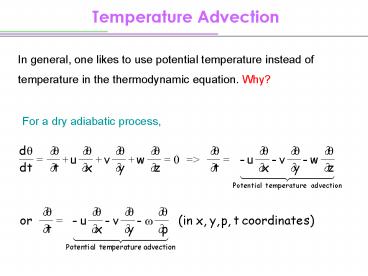Temperature Advection - PowerPoint PPT Presentation
1 / 20
Title:
Temperature Advection
Description:
Using the surface pressure and 1000-500 mb thickness chart to compute advection. ... distance between points a and b, and Dn is the distance between the points b and ... – PowerPoint PPT presentation
Number of Views:94
Avg rating:3.0/5.0
Title: Temperature Advection
1
Temperature Advection
In general, one likes to use potential
temperature instead of temperature in the
thermodynamic equation. Why?
For a dry adiabatic process,
2
Temperature Advection
Warm or cold temperature advection?
3
Temperature Advection
In nature coordinates, these equations are
written as
4
Temperature Advection
Considering only the horizontal advection, the
equations become
Similar to the previous example for the pressure
gradient calculation, we need to compute only one
advection term if we use the natural coordinates
and make the s direction along the wind
direction.
V
5
Temperature Advection
V
The finite difference form to compute the
advection term can be written as
using the forward in time and centered difference
in space, or
6
Temperature Advection
V
using the forward in time and upstream method in
space. In using the equation in the nature
coordinates , we may find it advantageous to
choose Ds as the distance across two isotherms.
That will predetermine the value of q (s,n,t) -
q (s-Ds,n,t) and all we have to do is to measure
the distance of Ds.
7
Temperature Advection
Looking at the equation for the temperature
advection again
On a constant p surface, it can be written as
(From the Poisson equation!)
8
Thermal Wind
Estimate the temperature advection and the change
of static stability using a hodograph
Vg1 lower-level geostrophic wind Vg2
upper-level geostrophic wind
VT
COLD
WARM
Tv Virtual Temperature
The thermal wind equation
9
Temperature Advection
Let us use the natural coordinate and choose the
s direction along the thermal wind (and along the
isotherms with cold air to the left). Now
rotating the x axis to the s direction, we get
the advection equation as
where is the average wind speed perpendicular
to the thermal wind.
The sign of
VT
VT
-
10
Temperature Advection
WARM
VT
VT
COLD
-
COLD
WARM
Warm temperature advection
Cold temperature advection
11
Temperature Advection
Procedure to Estimate the temperature
advection. 1. Plot a hodograph showing the
upper- and low-level wind and the thermal
wind. 2. For the layer of interest, measure
, the wind speed perpendicular to the
thermal wind. Be sure that is positive
if the wind is veer with height (warm
advection) and negative is the wind is back
with height (cold advection) 3. Estimate
temperature advection. This procedure can be
used to determine the temperature change due to
advection in any layer. If there is warm
advection in the lower layer, or cold advection
in the upper layer, or both, the environment will
become more unstable.
12
Temperature Advection
Temperature advection using 1000-500 mb
thickness The hypsometric equation
where Hz2-z1 is the thickness. Using the
conclusion that, for a fixed layer where
ln(p1/p2) is a constant, the thickness is
proportional to the layer averaged temperature.
Take derivative with respect to n, we get
13
Temperature Advection
Again ignore the difference between temperature
and virtual temperature, we can get
n
s
Vg1, Vg2 , and all have the same Vn, the
wind component perpendicular to the thermal wind
(or in the n direction). The component along the
thermal wind (or in the s direction) does not
contribute the temperature advection. (so lets
just use 1000 mb wind)
14
Temperature Advection
Using the surface pressure and 1000-500 mb
thickness chart to compute advection. The
surface pressure pattern should be similar to the
1000 mb geopotential height pattern and the
geostrophic wind on these two maps should be
similar. The following explanation is quite
straightforward in vector calculus. Using the
geostrophic equation in nature coordinates
We have two components here because now the s
direction in not along the wind.
15
Temperature Advection
Substitute the Vn equation into the temperature
change equation
We get
In finite difference form, it is
16
Temperature Advection
Dp 400 Pa and DH 60 m. Ds is the distance
between points a and b, and Dn is the distance
between the points b and b'. DsDn is therefore
the area of the rhomboid (abcd). We can conclude
that the temperature advection is inversely
proportional to the area formed by the
intersection of the isobars and thickness lines.
17
Temperature Advection
The effect of temperature advection on vertical
velocity Horizontal warm advection is one of the
key factors in creating upward motion. In an area
of warm advection, cold air is replaced by the
warm air and the surface pressure will have to
fall. That will create a low pressure in this
area, which in turn will create convergence and
upward motion. The magnitude of the upward motion
is proportional to the intensity of the warm
advection and inversely proportional to the area
of warm advection. The first point is obvious.
The second point can be illustrated below
18
Temperature Advection
Suppose the pressure is constant at the
beginning. The two circles are areas of warm
advection and the pressure drop due to the warm
advection. Even though the pressure drops are the
same, the pressure gradient in area B is 2/3 of
that in area A. The magnitude of the convergence
and vertical velocity in area B will be
proportionally smaller. Cold advection will
increase the surface pressure and produce
divergence and downward motion.
19
Temperature Advection
Temperature advection and the change of
atmospheric stability?
Absolute unstable!
Cold advection stabilized
Warm advection destabilized
20
Temperature Advection
The effect of vertical advection on temperature
In area of warm advection, the associated
upward motion will cool the atmosphere and
partially offset the effect of the warm
advection. The temperature change due to vertical
velocity can be estimated first using the
potential temperature change equation and then
converted to temperature.































